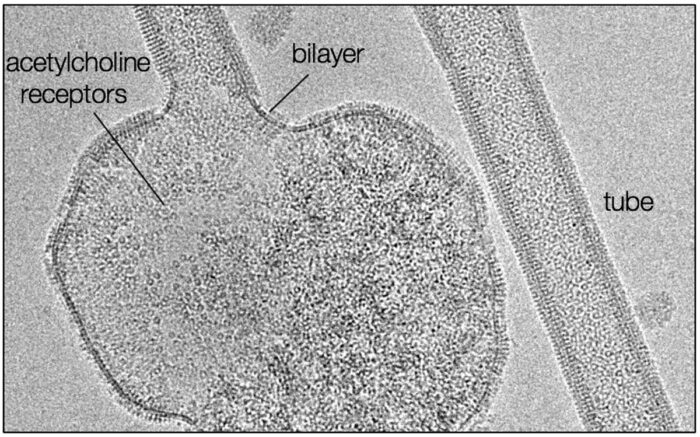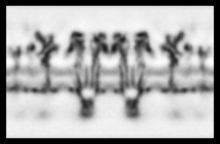Study reveals how lipids of cell membranes can form ordered, hydrophobic ‘skins’ in regions of high cholesterol concentration

Cell membranes are fundamental components of all living organisms, yet little is known about their structure, largely due to their mobility and vast lipid component arrangements. Nigel Unwin in the LMB’s Neurobiology Division has used electron cryo-microscopy (cryo-EM) to determine the structure of a cholinergic cell membrane, revealing the importance of cholesterol in enabling rapid and efficient neuromuscular transmission.
Working with the Marine Station at Roscoff and the British Antarctic Survey, Nigel looked at the cholinergic cell membrane in the electric organ of the Torpedo ray, which resembles the muscle cell membrane at the nerve-muscle synapse. The cholinergic cell membrane is rich in transmitter-gated ion channels called acetylcholine receptors. This membrane, when isolated, forms long, tubular vesicles in which the channels pack tightly together in the same ordered arrangement as exists at the synapse in situ.

The regular packing of protein, and the reasonably ordered cholesterol inside the membrane bilayer allowed Nigel to determine the whole membrane structure using cryo-EM and helical image reconstruction. His results showed that lipids in a membrane bilayer can form a non-fluid ‘skin’ in regions where cholesterol is enriched, contradicting prior assumptions that lipids are in a fluid state.
This finding builds upon Nigel’s previous research where he determined that cholesterol attaches to specific sites on the transmembrane helices, and forms aggregates known as ‘cholesterol bridges’ to link one protein to the next.
The newly-identified lipid non-fluid ‘skin’ is likely to be a recurring motif in cholesterol-enriched regions of animal cell membranes. This is thought to be the case as the ‘skin’ only involves the sterol group of cholesterol and the initial saturated portions of the phospholipid chains, meaning it is not dependent on interactions involving the invariably heterogeneous headgroup and tail portions of the lipids.
This finding shows the importance of cholesterol in organising acetylcholine receptors within the membrane to aid function. Both ‘cholesterol bridges’ and ‘lipid skins’ may play important roles in cell membranes as they provide ways of organising and maintaining interacting proteins in optimal arrangements across the membrane, allowing proteins to work more efficiently as functional units within the cell membrane and promoting cooperative activity for better health.
This work was funded by UKRI MRC.
Further references
Structure of a cholinergic cell membrane. Unwin, N. PNAS, 2022, Vol. 119(34), e2207641119
Nigel Unwin’s page
The Marine Station, Roscoff
British Antarctic Survey
Previous papers from Nigel Unwin
Protein-lipid architecture of a cholinergic postsynaptic membrane. Unwin, N. IUCrJ, 2020, Vol. 7, pp.852-857
Segregation of lipids near acetylcholine-receptor channels imaged by cryo-EM. Unwin, N. IUCrJ, 2017, Vol. 4, pp.393-399